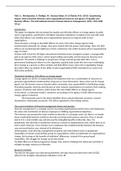Tatli, A., Nicolopoulou, K. Özbilgin, M., Karatas-Ozkan, M. & Öztürk, M.B. (2015). Questioning
impact: Interconnection between extra-organizational resources and agency of equality and
diversity officers. The International Journal of Human Resource Management, 26(9), 1243-1258.
(15 p.)
Introduction
This paper investigates the role played by equality and diversity officers as change agents in public
sector organizations, specifically in UK higher education institutions. It explores how and with what
effect E&D officers can mobilize extra-organizational resources to improve E&D in their
organizations.
There has been a change in how E&D officers are seen. First when change agents made
transformative demands for change, they were viewed with low power and prestige. Now, the E&D
officers are ascribed greater legitimacy in their coextensive role within business-driven organizational
logic of action.
Another shift is that the UK higher educational institutions have changed to project a managerialist
grip on all aspects of this sector, where target-setting and quality control measures became more
important. This posed a challenge to progressive change towards greater E&D. Also, cuts in
government funding and reforms to the regulatory equality body made this even more challenging.
Since change as a process is often complex and E&D officers have a key role in negotiating change,
this article offers an analysis of the utility of extra-organizational E&D mechanisms as a part of an
E&D action portfolio.
Theoretical backdrop: E&D officers as change agents
Change agents are drivers of organizational development who use a combination of resources to
generate organizational transformation along one or more dimensions. Many actors can be change
agents, but the human resource function often commands a key responsibility in facilitating change.
Promoting equality, diversity and inclusion at work requires organizations to transform their existing
systems, structures and cultures, which shows the role of E&D officers as change agents.
In this article, a contextual model is needed in accounting for the agency of E&D officers because
change agency is dynamic.
The framework used in the article identifies three context-informed constructs, namely
situatedness, relationality and praxis. This will be explained in the findings section.
The recent evolution of diversity management theory and practice
Diversity management is a strategic tool for increasing organizational performance and emphasizes
the value and contribution of diverse employees in fulfilling organizational objectives.
The business case perspective treats workforce diversity as a strategic asset, but there is no simple
linear relationship between workforce diversity and improved business outcomes. Thus, it should
look at it in a more holistic way and also see the intangible benefits of diversity. Also, it is
problematic that diversity is sometimes viewed as a means to organizational ends, rather than as an
end in itself. However, more scholars try to emphasize the complementarity between the business
case and social justice case, instead of its dichotomy.
Unfortunately, most diversity management programs and interventions seem to perpetuate
inequalities of certain social identity groups in organizations, which is problematic for organizational
change. By focusing on the benefits of individual’ differences, instead of the group-based
inequalities, this struggle for change can be decreased.
For E&D officers to achieve progressive change, they need to challenge the status quo and look at
multiple strategic resources of diversity.
Research methods
The data for the paper was collected qualitatively, through structured interviews with 26 E&D
officers from 20 higher educational institutions in the UK.




